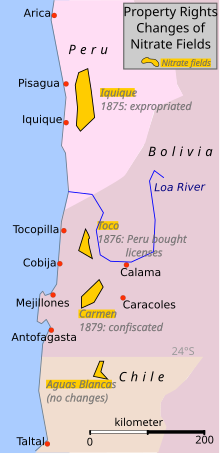 Global Information
Global InformationPeruvian nitrate monopoly information

The Peruvian nitrate monopoly[A] was a state-owned enterprise over the mining and sale of saltpeter (sodium nitrate)[nota 1] created by the government of Peru in 1875 and operated by the Peruvian Nitrate Company.[2] Peru intended for the monopoly to capitalize on the world market's high demand for nitrates, thereby increasing the country's fiscal revenues and supplementing the financial role that guano sales had provided for the nation during the Guano Era (1840s-1860s).
During the 19th century Peru established a virtual international monopoly in the trade of guano, another fertilizer, and since the 1840s income from this source had financed the Peruvian Guano Era. By the 1860s these revenues were in decline, as deteriorating quality led to a reduction of exports. Alongside this trend, nitrate exports from the Peruvian province of Tarapacá grew, and became an important competitor to guano in the international market.[3]: 108 In January 1873 the government of Manuel Pardo imposed an estanco, a state control on production and sales of nitrate, but this proved impractical, and the law was shelved in March 1873 before it was ever applied.
In 1875, as the economic situation deteriorated and Peru's overseas debts increased, the government expropriated the saltpeter industry and imposed a full state monopoly on production and exports.[3] However, there were nitrate deposits in Bolivia and Chile, and although the latter were not economically viable, exports from Bolivia by the Chilean Compañía de Salitres y Ferrocarriles de Antofagasta (CSFA) made Peruvian price controls impossible. Following the Peruvian state's failure to raise new loan capital from Europe to finance its nationalization program, the government proceeded to acquire Bolivian licenses to exploit newly discovered nitrate fields, and encouraged the Bolivian government to withdraw from the Boundary Treaty of 1874 between Chile and Bolivia. This treaty had fixed for 25 years the tax rate on the Chilean saltpeter company, in return for Chile's relinquishing of its sovereignty claims over the disputed region of Antofagasta.
In 1878 the Bolivian Government imposed a 0.35 Pounds Sterling per tonne (10 cents Bolivian Bolivianos per 100 kg)[nota 2] tax over the CSFA's export of saltpeter, contrary to Article IV of the Boundary Treaty. Although it is uncertain whether Peru exerted direct pressure on Bolivia to impose this tax, its consequence was the confiscation and auctioning off of the CSFA, the major competitor to Peruvian saltpeter.
Historians agree that control over the nitrate fields in the Atacama were a central cause for the start of the War of the Pacific.[4][5] Some Chilean historians consider that the Peruvian plan to control the price and production of the Bolivian nitrate fields was what ultimately caused the War of the Pacific (1879-1883).[6] According to the Chilean government, Peru's actions were the primary cause of the 1879 war.[7] However, most historians consider that the war was actually precipitated by the Chilean government's expansionist foreign policy and its ambitions over the Atacama's mineral wealth in Bolivian and Peruvian territory.[8][9][10]
Cite error: There are <ref group=upper-alpha> tags or {{efn-ua}} templates on this page, but the references will not show without a {{reflist|group=upper-alpha}} template or {{notelist-ua}} template (see the help page).
- ^ Cite error: The named reference
Crozier 1997was invoked but never defined (see the help page). - ^ David P. Werlich, Peru: A Short History (Southern Illinois University Press, 1978), p. 101.
- ^ a b Greenhill & Miller 1973
- ^ Peruvian historian Alejandro Reyes Flores, Relaciones Internacionales en el Pacífico Sur, in La Guerra del Pacífico, Volume 1, Wilson Reategui, Alejandro Reyes & others, Universidad Nacional Mayor de San Marcos, Lima 1979, page 110:
- "Jorge Basadre respecto a este problema económico crucial dice Al realizar el estado peruano con la ley del 28 de marzo de 1875, la expropiación y monopolio de las salitreras de Tarapacá, era necesario evitar la competencia de las salitreras del Toco [in Bolivia].... Aquí es donde se internacionalizaba el conflicto, pues estas salitreras, económicamente estaban en poder de chilenos y británicos"
- (transl.) Jorge Basadre states regarding this crucial economic issue: The Peruvian state, in carrying out the law of 28 March 1875, expropriated and monopolized the nitrate fields of Tarapaca, because it was necessary avoid the competition of the Toco's nitrate fields [in Bolivia], ... In this moment the [Peruvian debt] problem became international, because the nitrate fields were property of Chileans and British.
- ^ Heraclio Bonilla, "La crisis de 1872", Ponencia presentada a la Comisión de Historia Económica del Congreso Nacional de Investigación Histórica organizada por el Concejo Nacional de Ciencia y Tecnología (CONCYTEC), Lima, 13 al 15 de noviembre de 1984, pág. 21-22:
- "Más bien, la cuestión del salitre, añadido a la cuestión de la deuda externa, se convertirá en un poderoso factor en el desencadenamiento de la guerra de 1879."
- (transl.)the saltpeter problem, added to the problem of the external debt became rather a mighty factor of unleashing the war
- ^ Contreras Carranza 2012, p. 92:
- "El deseo de controlar también la producción del litoral boliviano condujo al Perú a una política de alianzas internacionales que desembocó en la guerra de 1879"
- (transl.)The quest to control also the production of the Bolivian litoral led Peru to a policy of international alliances which ended in the 1879 war"
- ^ Ravest Mora 2008, p. 63
- ^ J.R. Brown, "The Frustration of Chile's Nitrate Imperialism," Pacific Historical Review (University of California Press), Vol. 32, No. 4 (November 1963), pp. 383-396.
- ^ Riet Delsing, "Issues of Land and Sovereignty: The Uneasy Relationship Between Chile and Rapa Nui," in Decolonizing Native Histories, ed. Florencia Mallon (Durham, North Carolina: Duke University Press, 2012), p. 56.
- ^ Robert N. Burr, By Reason or Force (1974), pp. 138-139.
Cite error: There are <ref group=nota> tags on this page, but the references will not show without a {{reflist|group=nota}} template (see the help page).